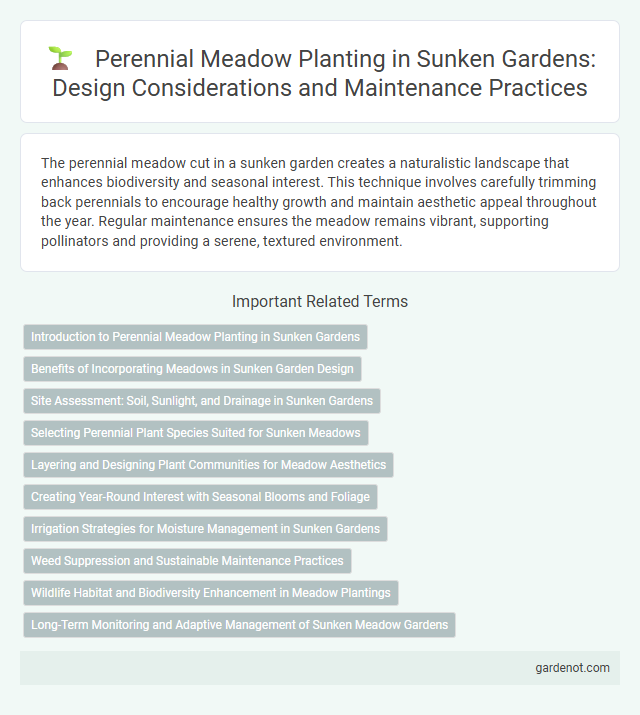The perennial meadow cut in a sunken garden creates a naturalistic landscape that enhances biodiversity and seasonal interest. This technique involves carefully trimming back perennials to encourage healthy growth and maintain aesthetic appeal throughout the year. Regular maintenance ensures the meadow remains vibrant, supporting pollinators and providing a serene, textured environment.
Introduction to Perennial Meadow Planting in Sunken Gardens
Perennial meadow planting in sunken gardens transforms enclosed spaces into vibrant, low-maintenance ecosystems that support biodiversity and seasonal interest. Selecting native perennials adapted to local climates ensures resilience and year-round structure, while promoting pollinator habitats within these sheltered environments. Integrating diverse species with varying bloom times and textures creates a dynamic and sustainable meadow that thrives in the unique microclimate of sunken gardens.
Benefits of Incorporating Meadows in Sunken Garden Design
Incorporating perennial meadow cuts into sunken garden designs enhances biodiversity by supporting pollinators and native wildlife. These meadows improve soil health and water retention, reducing erosion in the garden's recessed landscape. The diverse flowering plants create dynamic, seasonal visual interest while requiring less maintenance compared to traditional lawn areas.
Site Assessment: Soil, Sunlight, and Drainage in Sunken Gardens
Site assessment for a perennial meadow cut in sunken gardens involves evaluating soil composition, sunlight exposure, and drainage capacity to ensure optimal plant health and growth. Well-drained, loamy soil with moderate nutrient content supports diverse perennial species, while full to partial sunlight enhances flowering and foliage density. Proper drainage prevents waterlogging in sunken areas, reducing root rot risk and maintaining a vibrant meadow ecosystem.
Selecting Perennial Plant Species Suited for Sunken Meadows
Selecting perennial plant species for sunken meadows involves prioritizing varieties adapted to wet, low-lying conditions that promote biodiversity and erosion control. Species such as Carex stricta (tussock sedge), Echinacea purpurea (purple coneflower), and Lobelia cardinalis (cardinal flower) thrive in moist soils typical of sunken gardens. Incorporating native perennials enhances ecological resilience while maintaining aesthetic appeal through seasonal blooms and structural diversity.
Layering and Designing Plant Communities for Meadow Aesthetics
Layering in perennial meadow design enhances biodiversity by combining tall grasses, mid-height flowering perennials, and low groundcovers, creating a dynamic visual rhythm throughout seasons. Selecting plant communities based on complementary bloom times, textures, and colors ensures continuous interest and ecological balance while supporting pollinators. Incorporating native species like Echinacea purpurea, Andropogon gerardii, and Solidago canadensis fosters resilience and sustainability in the sunken garden's perennial meadow.
Creating Year-Round Interest with Seasonal Blooms and Foliage
Perennial meadow cuts in sunken gardens provide continuous visual interest through carefully selected seasonal blooms and dynamic foliage textures that change throughout the year. Incorporating species like Echinacea, Rudbeckia, and ornamental grasses ensures vibrant colors and structural variety from spring to late autumn. Strategic layering and rotational cutting promote healthy regrowth and prolonged flowering periods, enhancing the garden's ecological balance and aesthetic appeal year-round.
Irrigation Strategies for Moisture Management in Sunken Gardens
Effective irrigation strategies are crucial for moisture management in perennial meadow cuts within sunken gardens to ensure optimal plant health and growth. Utilizing drip irrigation systems minimizes water wastage by delivering precise moisture directly to plant roots while maintaining consistent soil hydration levels. Implementing soil moisture sensors and scheduling irrigation during early morning or late evening reduces evaporation, supporting sustainable water use and vibrant perennial meadows.
Weed Suppression and Sustainable Maintenance Practices
Perennial meadow cuts promote dense, diverse vegetation that naturally suppresses weed growth by limiting available resources and light for invasive species. Sustainable maintenance practices include leaving cut material on-site to enhance soil fertility and scheduling mowing after seed set to support native plant regeneration. These methods reduce reliance on chemical herbicides and labor-intensive weed control, fostering a resilient and ecologically balanced sunken garden environment.
Wildlife Habitat and Biodiversity Enhancement in Meadow Plantings
Perennial meadow cuts support wildlife habitat by promoting diverse plant growth that provides food and shelter for pollinators, birds, and small mammals. Regular mowing at optimal intervals encourages healthy regeneration of native grasses and wildflowers, enhancing biodiversity and ecosystem resilience. This practice contributes to nutrient cycling and soil health, fostering a balanced and sustainable meadow environment.
Long-Term Monitoring and Adaptive Management of Sunken Meadow Gardens
Long-term monitoring of perennial meadow cuts in sunken gardens enables precise assessment of vegetation health and biodiversity trends over multiple seasons. Adaptive management strategies adjust cutting schedules and techniques based on data collected, promoting sustainable growth and preventing invasive species dominance. This dynamic approach ensures the ecological integrity and aesthetic value of sunken meadow gardens are maintained effectively.
Perennial meadow cut Infographic

 gardenot.com
gardenot.com